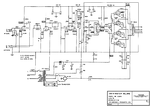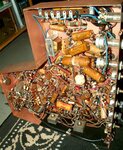riffwraith
Junior Member level 2

Hi all 
First post here, and hopefully this will not be frowned upon as being too rudimentary.
How does one go about learning to read a schematic?
I have a schematic for my guitar amplifier, which can be found here:

https://el34world.com/charts/Schema...shall_2203_jmp_master_volume_lead_100watt.gif
I am trying to gain the ability to look at the schematic, find something there, and then find the correlating item in the circuit. But I can't seem to. Looking at the schematic, I am trying to follow the signal from the inputs ("Lo sens" and "hi sens"), and I am doing ok there, but when I look at the circuit (my amp), I am not seeing what I see on the page, and I get lost.
I can post a pic of the amp if need be.
Can someone fill me in here? I am not looking for a detailed explanation on what everything is, just a good way to start understanding how to look at the schematic and the actual circuit, and see how they correlate.
Thanks in advance.
First post here, and hopefully this will not be frowned upon as being too rudimentary.
How does one go about learning to read a schematic?
I have a schematic for my guitar amplifier, which can be found here:

https://el34world.com/charts/Schema...shall_2203_jmp_master_volume_lead_100watt.gif
I am trying to gain the ability to look at the schematic, find something there, and then find the correlating item in the circuit. But I can't seem to. Looking at the schematic, I am trying to follow the signal from the inputs ("Lo sens" and "hi sens"), and I am doing ok there, but when I look at the circuit (my amp), I am not seeing what I see on the page, and I get lost.
I can post a pic of the amp if need be.
Can someone fill me in here? I am not looking for a detailed explanation on what everything is, just a good way to start understanding how to look at the schematic and the actual circuit, and see how they correlate.
Thanks in advance.





